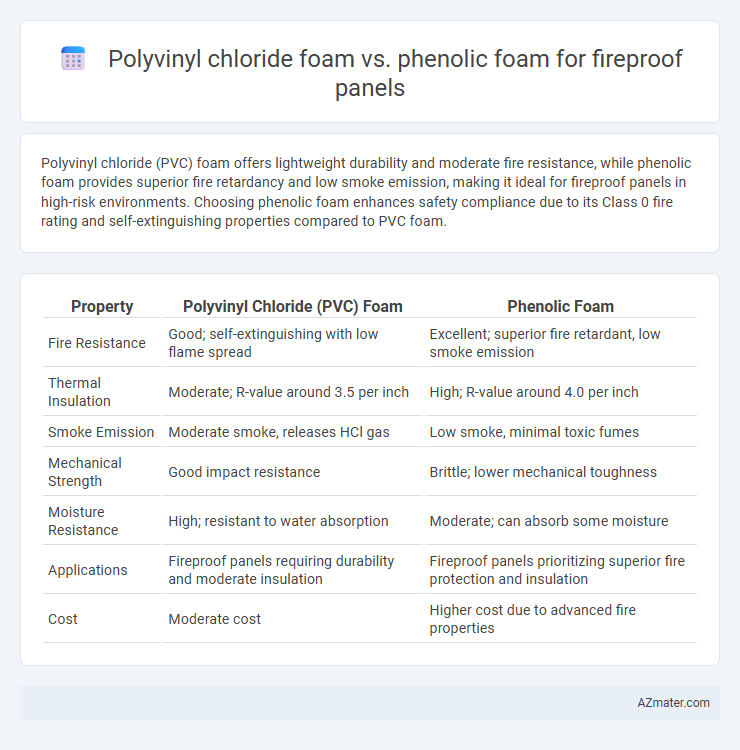Polyvinyl chloride (PVC) foam offers lightweight durability and moderate fire resistance, while phenolic foam provides superior fire retardancy and low smoke emission, making it ideal for fireproof panels in high-risk environments. Choosing phenolic foam enhances safety compliance due to its Class 0 fire rating and self-extinguishing properties compared to PVC foam.
Table of Comparison
| Property | Polyvinyl Chloride (PVC) Foam | Phenolic Foam |
|---|---|---|
| Fire Resistance | Good; self-extinguishing with low flame spread | Excellent; superior fire retardant, low smoke emission |
| Thermal Insulation | Moderate; R-value around 3.5 per inch | High; R-value around 4.0 per inch |
| Smoke Emission | Moderate smoke, releases HCl gas | Low smoke, minimal toxic fumes |
| Mechanical Strength | Good impact resistance | Brittle; lower mechanical toughness |
| Moisture Resistance | High; resistant to water absorption | Moderate; can absorb some moisture |
| Applications | Fireproof panels requiring durability and moderate insulation | Fireproof panels prioritizing superior fire protection and insulation |
| Cost | Moderate cost | Higher cost due to advanced fire properties |
Introduction to Fireproof Panels
Fireproof panels utilize specialized materials like polyvinyl chloride (PVC) foam and phenolic foam, each offering distinct fire resistance properties. Polyvinyl chloride foam provides good flame retardancy with moderate smoke production, while phenolic foam excels in thermal insulation and emits low smoke density during combustion. Selection between PVC and phenolic foam depends on specific fire safety standards, insulation requirements, and application settings in fireproof panel construction.
Overview of Polyvinyl Chloride (PVC) Foam
Polyvinyl chloride (PVC) foam is a lightweight, closed-cell material known for its excellent fire resistance and low smoke emission, making it suitable for fireproof panels. Its high thermal stability and self-extinguishing properties provide enhanced safety in construction and industrial applications. Compared to phenolic foam, PVC foam offers superior mechanical strength and moisture resistance, ensuring durability under harsh environmental conditions.
Overview of Phenolic Foam
Phenolic foam stands out in fireproof panel applications due to its exceptional fire resistance, low smoke emission, and high thermal stability compared to polyvinyl chloride (PVC) foam. Its closed-cell structure provides superior insulation while maintaining structural integrity at elevated temperatures. Commonly used in construction and transportation sectors, phenolic foam offers enhanced fire safety and environmental performance.
Fire Resistance Comparison: PVC Foam vs Phenolic Foam
Phenolic foam exhibits superior fire resistance compared to polyvinyl chloride (PVC) foam due to its inherent char-forming properties and low flammability, which significantly slow down heat propagation and smoke generation. PVC foam tends to release toxic gases and melts under high temperatures, compromising fireproof panel integrity and safety. Phenolic foam's compliance with stringent fire safety standards such as ASTM E84 Class A underscores its effectiveness in fireproof panel applications.
Thermal Insulation Properties
Polyvinyl chloride (PVC) foam demonstrates moderate thermal insulation with a typical thermal conductivity ranging from 0.035 to 0.045 W/m*K, making it effective in reducing heat transfer in fireproof panels. Phenolic foam, known for its superior fire-resistant properties, offers lower thermal conductivity values around 0.020 to 0.030 W/m*K, enhancing insulation performance while maintaining flame retardancy. The closed-cell structure of phenolic foam contributes to its lower thermal conductivity and higher thermal stability compared to PVC foam, making it preferable for applications requiring stringent fireproof standards and efficient thermal insulation.
Smoke and Toxic Gas Emissions During Combustion
Phenolic foam exhibits significantly lower smoke density and toxic gas emissions compared to polyvinyl chloride (PVC) foam when used in fireproof panels, due to its inherent charring behavior that limits combustion by-products. Polyvinyl chloride foam releases dense black smoke along with hazardous gases like hydrogen chloride and dioxins during burning, posing greater health risks and complicating fire safety measures. Fire-resistant materials with low smoke and toxic gas emissions, such as phenolic foam, are preferred in building applications to enhance occupant safety and compliance with stringent fire protection regulations.
Mechanical Strength and Durability
Polyvinyl chloride (PVC) foam exhibits superior mechanical strength, offering high impact resistance and flexibility, which enhances its durability in fireproof panel applications. Phenolic foam, while excellent in fire resistance and thermal insulation, tends to be more brittle and less able to withstand mechanical stress over time. The choice between PVC and phenolic foam depends on the required balance between structural robustness and fireproofing performance.
Environmental Impact and Sustainability
Polyvinyl chloride (PVC) foam exhibits challenges in environmental impact due to the release of toxic chlorine-based compounds during production and combustion, posing concerns for sustainability and recyclability. Phenolic foam demonstrates superior fire resistance with low smoke and toxic gas emissions, making it a more environmentally friendly choice for fireproof panels while supporting improved sustainability goals through better thermal insulation and longer lifespan. Selection between PVC foam and phenolic foam for fireproof panels often hinges on balancing environmental regulations with performance requirements in sustainable building practices.
Cost Analysis of PVC and Phenolic Foam Panels
PVC foam panels typically offer a lower initial cost compared to phenolic foam panels, making them a more budget-friendly option for fireproofing applications. Phenolic foam panels, while more expensive upfront, provide superior fire resistance and longer durability, which can lead to cost savings over the panel's lifecycle due to reduced maintenance and replacement needs. The choice between PVC and phenolic foam panels should consider both initial investment and long-term performance to optimize fireproofing budget efficiency.
Choosing the Best Foam for Fireproof Panel Applications
Phenolic foam offers superior fire resistance and low smoke emission compared to polyvinyl chloride (PVC) foam, making it ideal for fireproof panel applications demanding high safety standards. PVC foam provides good mechanical strength and moisture resistance, but its combustibility and higher smoke output limit its use in critical fireproofing scenarios. Selecting phenolic foam enhances panel performance in fire-rated assemblies by ensuring compliance with stringent fire safety codes and reducing fire hazards in buildings.

Infographic: Polyvinyl chloride foam vs Phenolic foam for Fireproof Panel
 azmater.com
azmater.com